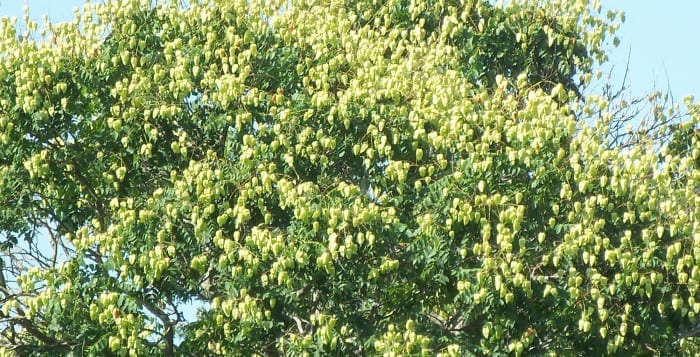By Ellen Barcel
Have you ever walked or driven past a plant you just loved — one you might even want to add to your garden, but you don’t know what it is? Maybe no one’s around to ask? Yes, identifying an unknown plant can be challenging.
For a number of years, I had seen a unique tree with yellow spring flowers followed by seed pods which start out green but then turn a brownish color, resembling paper lanterns. Each pod contains several seeds. I asked a number of gardening friends, yet no one was able to identify it. Finally I resorted to the web, and in just a few minutes, quickly found the answer.
The tree was a goldenrain tree (Koelreuteria paniculata), a native of Asia. It is also called Pride of India or China tree. The small- to medium-sized tree makes a nice specimen or ornamental tree and is grown in home gardens primarily for that purpose. The mature tree is about as wide as it is tall. In autumn, the leaves turn bright yellow. It even has winter interest as some of the “lanterns” will remain on the tree for a while.
While some consider the goldenrain tree invasive, particularly in Florida, it is not on Suffolk County’s banned or management lists. The management list consists of plants which, while currently legal to sell or propagate, are considered somewhat invasive and therefore it is recommended they not be planted. The low maintenance tree does well in hardiness zones 5 to 9, meaning that an unusually cold winter, like we’ve had the last two winters, should not be a problem. The moderate to quickly growing tree prefers full sun. It even tolerates a bit of a dry spell, meaning that Long Island’s occasional droughts will not affect the tree. It is somewhat salt tolerant, so should do well near roads where winter salt spray hits nearby plants, and tolerates some pollution. All in all, it’s a sturdy tree with few pests and year-round interest.
It does well in varying soil pH levels, from strongly acidic, 5.1 to 5.5, through mildly alkaline, 7.8. This means that you can plant it in areas where you have “rhodies” and azaleas, which require very acidic soil, or in a lawn where you find yourself liming the soil to make it more alkaline. As with all trees, keep the grass away from the trunk so that lawn mowers and “Weedwackers” don’t damage the bark.
Another identification needed was of a “really cool” hanging plant a gardening friend of mine saw at a recent home and garden show. I recognized it immediately as a variety of sedum, but which one? Another quick online search gave the name — Sedum morganianum. It’s a flowering perennial plant, a succulent, note the blue-green fleshy leaves, native to Mexico and Honduras.
This sedum can be grown outdoors in late spring, summer and early fall, but once it gets really cold, needs to be grown indoors as a houseplant. Don’t overwater — sedum can rot in soil that isn’t well drained. It propagates easily from broken pieces (the plant is somewhat fragile when touched), just like most cacti. If grown indoors, it likes a sunny location but not excessive heat. It’s also known as burro’s tail because of its unusual shape. Like most succulents, it needs good drainage.
As this plant can get very large, make sure to put it in a sturdy container. A hanging basket is best or a large pot on a pedestal, both of which show off its training nature. Dark red flowers appear April to July.
To track down an unidentified plant using the web, type the description into your search engine. I used “photo trees with seed pods” and up popped dozens of possibilities. I was then easily able to pick out the goldenrain tree. For the sedum, I typed in “photo sedum hanging basket.”
Ellen Barcel is a freelance writer and master gardener. To reach Cornell Cooperative Extension and its Master Gardener program, call 631-727-7850.





